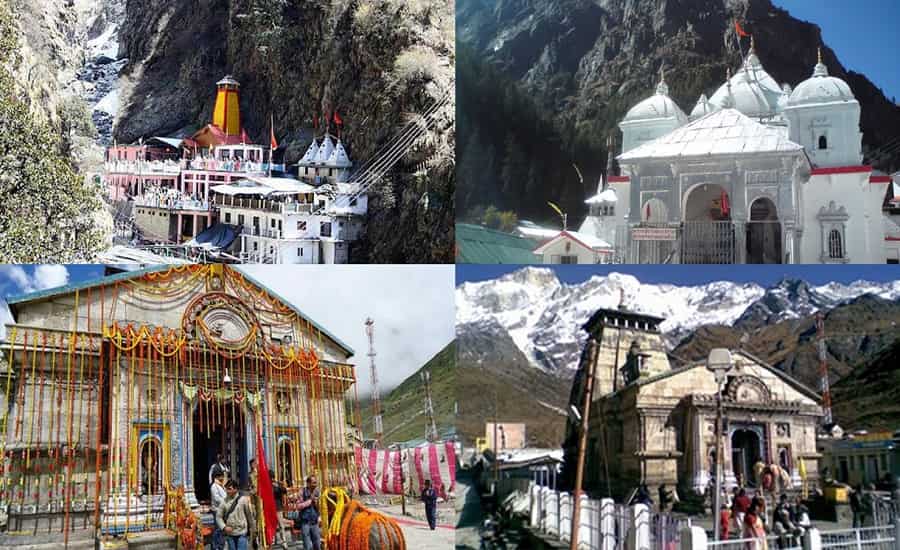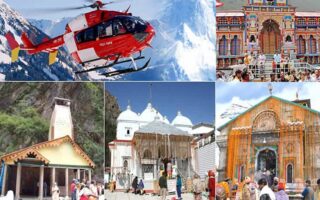The holy Chardham of the Garhwal Himalayas includes the four major pilgrimage abodes-the Yamunotri, Gangotri, Kedarnath, Badrinath. The term ‘Chardham’ has been coined from the All-India ‘Chardham’ umbrella term.
The All-India Chardham namely, Dwarka, Puri, Rameshwaram and Badrinath, are the four cardinal pilgrimage centers in four corners of the country established by spiritual guru Shankaracharya around the 8th century. Chota Chardham of Uttarakhand replicates the All-India Chardham circuit in spiritual significance and potency. Each of the Dham in the Chota Chardham circuit comes with its own exclusive history. The Yatra starts with Yamunotri followed by Gangotri, then Kedarnath and ends with Badrinath finally. Read on to learn more..

History of Yamunotri
The temple of Yamunotri, an abode of Goddess Yamuna was constructed around 1839 by the Garhwal king, Tehri Naresh. This temple however was destroyed by a severe earthquake. Jaipur queen Guleria then reconstructed the temple around the 19th century. Yamunotri is the seat of River Yamuna whose geographical source is a glacier called Champasar lodged below Bandarpunch Parvat. According to myths Yamuna is Lord Surya’s and Goddess Sangya’s daughter and sister of God of death, Yama. Legends also say that the great sage known by the name of Asit Muni resided here in the ancient times. All through his life he bathed himself in River Ganga and River Yamuna. When he turned old and could not go all the way up to Gangotri a stream emerged from River Ganges and flowed apposite to Yamuma to facilitate his bathing rituals. Pilgrims today believe that they can get rid of all their miseries and their mortal fear of death by taking a dip in the sacred river Yamuna.
History of Gangotri
The consecrated Gangotri shrine standing along River Bhagirathi’s right bank and cradled at an elevation of about 3042 meters belongs to Goddess Ganga. The Gangotri temple was built around the first half of 18th century by the Gorkha general known by the name of Amar Singh Thapa. The shrine is looked upon as the point of origin of the mighty River Ganges. The geographical source of the river however is the famous Gangotri glacier, more specifically the ‘Gaumukh’ region of the Gangotri glacier. Myths hold that King Bhagiratha performed many centuries of rigorous penance sitting on the Bhagirath Shila in order to please Goddess Ganga and implore her to flow on earth instead of heaven. Ganga finally agreed to descend and came down with tremendous force. Lord Shiva held her in his matted curls of hair so that her force does not destroy the earth. The Jalmagna Shivling is the point where Lord Shiva received Devi Ganga onto his locks. The stream of Ganga then followed King Bhagiratha to touch the ashes of his ancestors and offer them with ‘Moksha’. Till date, the waters of River Ganga are considered holy enough to absolve all kinds of sins and lead one to the path of salvation.
History of Kedarnath
Kedarnath Dham, an abode of Lord Kedar, a form of Lord Shiva is one among the 12 famed Shiv Jyotirlingam that the country has. The unique pyramidal formation of the Shiva lingam at Kedarnath is a reminiscent of the legend that relates that lingam to the hump of a bull. Legend has it that when Pandavas came in search of Lord Shiva to redeem them and free them of their guilt and sins associated with the killing of their own cousins on the battlefield of Kurukshetra, Lord Shiva did not want to get such an easy respite. Thus, he eluded them by taking the guise of a bull and mingling among a herd of grazing cattle. But Bhima traced him out and while he attempted an escape his hump was left behind which now is worshipped as a sacred lingam at the Kedarnath shrine. Thus according to legendary records the Kedarnath temple dates back to the age of the Mahabharata.
History of Badrinath
Badrinath Dham is the abode of Lord Vishnu who resides in the shrine in the form of Badri Vishal. As per Skand Puran, Adi Guru Shankaracharya recovered Lord Badrinath’s idol from the Narad Kund and reinstated it in the temple of Badrinath Dham around the 8th century. Myths have it that Lord Vishnu had performed rigorous penance in this place and during that time Goddess Laxmi, his consort assumed the shape of a Badri or berry tree and shaded him from the scorching sun rays. Also myths declare that along the slopes of a peak at Badrinath Pandavas along with wife Draupadi ascended the path towards heaven.
